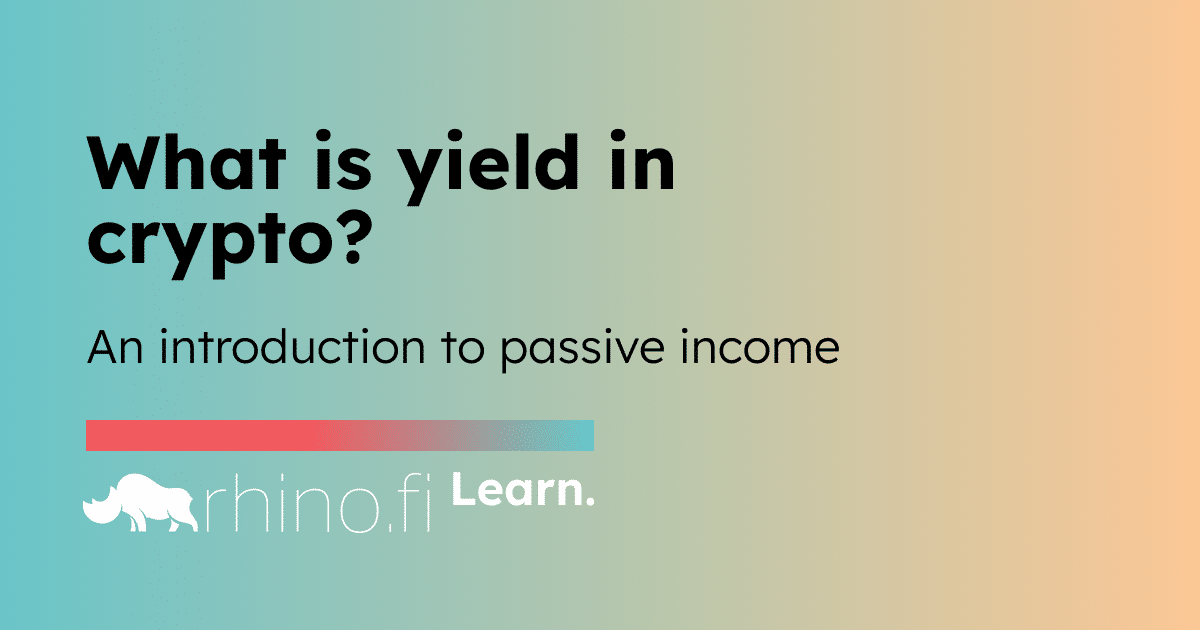The concept of yield is fundamentally simple: it’s all about the returns you make when you lend or invest your idle assets.
So, if you invest one hundred dollars’ worth of coins or tokens in an opportunity, and that opportunity pays out $10, then your yield is $10. Easy, right?
Well, actually, there are a whole load of other questions that spring up when we come to discuss yield. These include:
How do you earn crypto yields?
How do we calculate yield?
Why are crypto yields so high?
Where do I find the best crypto yields?
In this post, we’ll answer all these questions (and more).
How do you earn crypto yields?
Just like in the old world of fiat, there are loads of different ways you can earn yield on your spare assets. These include:
- Staking. Staking is where you dedicate your tokens to secure the future of a particular blockchain. Essentially, you volunteer your computer to validate transactions on your chosen network, and provide tokens as a proof of your commitment. You’ll earn validator fees for doing so.
- Lending. You can deposit your assets with crypto lending platforms, which then lend these assets to other users in exchange for interest. It’s similar to depositing funds in a bank – although, of course, there’s no bank.
- Liquidity mining. This strategy has exploded in popularity recently thanks to the development of automated market makers, or AMMs.
How do we calculate crypto yields?
When we talk about yields in crypto, we usually refer to a figure known as the annual percentage yield, or APY.
This is similar to the annual percentage rate (APR), which combines the headline interest rate with the fees you’re going to earn on top.
The APY, however, is slightly higher, because the assets you receive when you stake or lend your crypto often attract compound interest. That is, they don’t simply pay you a flat rate per year: they periodically harvest a fraction of the interest, add it to your investment and then harvest the next fraction on the revised base figure, so you get a bit more each time.
If you want a very simple example, imagine you’re earning 12% interest on a $100 investment but the opportunity compounds every month. So each month, you earn 1% compound interest (12% divided by the 12 months of the year).
The first month you will earn $1 (1% of $100), which takes you to $101. The next month you’ll earn $1.01 (1% of $101), which takes you to $102.01. And so on, and so on. By the end of the year, you’ll have earned slightly more than the 12% interest.
We’ve actually got a full explainer on APY, giving you a more detailed mathematical formula which you can use to calculate the return on any compounding opportunity. Or if you’d prefer to let someone else do the maths, you can use a crypto yield calculator like this one.
Why are crypto yields so high?
Crypto assets often pay out yields of 5%, 10% and even 20%, while the equivalent value of fiat passive income opportunities is far lower.
Why is this? Well, for four key reasons:
- There is no middleman. This is fundamental to the entire concept of DeFi; we don’t have faceless intermediaries taking their cut without adding value. We replace humans with technology in the form of smart contracts, creating a trustless system with minimal fees.
- The recent surge in interest has led to high demand from both investors and speculators, particularly for coins and tokens that are new to market and require liquidity to stimulate trading activity.
- Cryptocurrency markets are available 24/7, and thus require constant liquidity to service spikes in trading interest.
- Validators play a vital role in ensuring the security of blockchain transactions and protecting the long-term future of the network they support.
What are the risks of crypto yield opportunities?
Like fixed-income opportunities in fiat finance, crypto yield opportunities carry a certain amount of risk. This is a natural part of all financial investment. It’s nothing to do with the security of crypto and blockchain.
If a lending project collapses, or the underlying blockchain suffers a hack or damage to its credibility, this can affect the value of the yield opportunities that are hosted on top. Thankfully, however, this kind of event has been rare in blockchain history so far.
Where do I find the best crypto yields?
Yep, we know you’re eager to know this one! When we were researching this article and asking our community on social, the question ‘where do I find the best yields in crypto’ was the most popular query by far.
Well you’ll got two options here:
Use a DeFi yield aggregator like rhino.fi, which curates a handful of legit and reliable opportunities for you. We kick the tyres before we send any opportunity live, so you don’t have to do it yourself.
You can look for opportunities yourself. Protocols like Yearn, Balancer, Curve and Stargate (all of which are showcased on Rhino) are good places to start. But if you’re going to fly this mission solo, make sure you do your prep: if a project’s offering yields of more than 20%, you should go under the hood and take a proper look first.
If you want more info on the first option, you should check out our explainer post on DeFi aggregators, specifically the ‘what is a DeFi yield aggregator?’ section.
And if you have any other questions, feel free to reach out to us on Discord or Twitter. We’ll do our best to answer any question as best we can, so you can approach the savannah of passive income with confidence.





